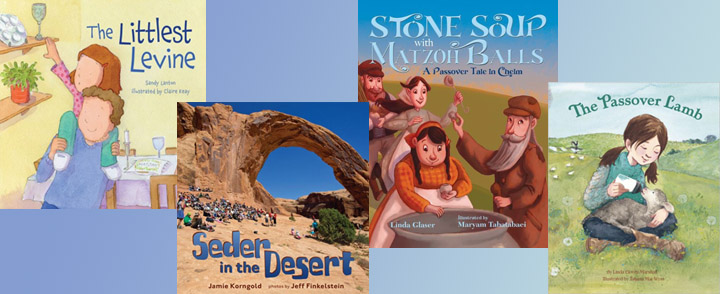By Rita Berman Frischer, Special to the Jewish Sound
Seder in the Desert (Lerner Publishing) shares a new vision of holiday celebration written by Rabbi Jamie S. Korngold, founder and spiritual leader of The Adventure Rabbi: Synagogue Without Walls. Korngold lives in Boulder, Colo., with her husband, noted photographer Jeff Finkelstein, whose stunning cover depicts people resting in the desert framed by a dramatic stone arch and blue sky, evoking parallels to the Biblical Exodus. The image reminds me viscerally not just of my years in the dry San Fernando Valley, but more happily of the exciting Temple Youth Group Passover expeditions that were an unforgettable part of Pesach for my two daughters each year.
For Jewish families in the great, green Northwest, the landscape might not be as familiar. But the outdoor sensibility certainly will be, as a group of families follow Rabbi Jamie into Moab, Utah to physically recreate the going out together. They hike, they help each other, and they schlep — the Torah, carefully, in a backpack, the food and the supplies. They climb, they observe, they thirst and, finally, they arrive and set up. Pictures of participants help explain the symbols. Like Miriam, the people dance with tambourines and sing. The image of everyone sitting on the ground ready to begin eating is like a time warp — except for the clothes. Miriam’s cup reminds everyone of the legendary well that followed to slake desert thirst they now have personally experienced. As the group turns back, to celebrate Havdalah and sing beneath a full moon, Finkelstein’s pictures, light and dark, help all ages feel part of the night, the adventure and the history.
To my delight, Rabbi Jamie has also lent her distinctive approach and her two daughters, Sadie and Ori, to a picture book, “Sadie’s Lag Ba’Omer Mystery,” which introduces this oft-overlooked “scholar’s holiday” and solves its mystery for Sadie — and for the rest of us. Setting it in relation to Purim and Pesach, Rabbi Jamie tells us all the things we don’t do on Lag Ba’Omer, the historical reason why we do the things we do, and the historical figure, Rabbi Shimon Bar Yochai, we honor. As a librarian, I got a kick reading about Sadie and Ori trying to find a library picture book explaining Lag Ba’Omer. There wasn’t one, really, until their mom decided to write it.
Julie Fortenberry’s paintings are lively and fun, leaving no mystery as to why this holiday is worth reading about and celebrating. One of my peak Jewish memories was being in Israel on Lag Ba’Omer with friends who took us to Mt. Meron. We watched as hundreds danced at the rabbi’s grave and as 3-year-old boys were shorn of their baby curls in a traditional ceremony, leaving babyhood behind (Kar-Ben).
In The Littlest Levine by Sandy Lanton, illustrated by Claire Keay (Kar-Ben), Hannah desperately wants not to be the baby of her family. Too little for school, too little to light Hanukkah candles, she hates being the littlest. But Hannah’s grandpa promises that her day will come. After Purim, he takes her off each evening to study. Then, on Passover, when the candles are lit and everyone is reading from the Haggadah, Hannah’s day does come: She is just the right size and age to ask the Four Questions — and perfectly, too.
Young Miriam, in The Passover Lamb by Linda Elovitz Marshall (Random House) is feeding chickens on the family farm, busily practicing “Ma nishtana…” for the first seder at her grandparents’ house, when she discovers that their sheep, Snowball, is giving birth. After triplets are born, two lambs begin nursing but the third one must be fed with a bottle if it is to survive. Miriam doesn’t want to miss the seder, but how can she save the lamb? Then she remembers Baby Moses in his basket and figures out what to do.
Miriam is obviously more clever and more generous than the worried residents faced with a hungry stranger in Linda Glaser’s Stone Soup with Matzoh Balls: A Passover Tale in Chelm with illustrations by Maryam Tabatabacei (Albert Whitman & Company). Based on the classic fable dating back hundreds of years, Glaser brings her enterprising stone-toting stranger into the equally fabled town of Chelm on the day of the first seder to see what happens. Will the people act in accordance with the Haggadah’s “Let all who are hungry come and eat?” Not until the stranger offers to show them how to make soup from his very special stone. All it takes is a pot and water. Maybe some onions? Salt? Celery? Chickens? Carrots? No problem. With the eager participation of everyone in the village, there’s soon enough delicious soup to let all who are hungry come and eat — together.
“That’s some stone,” the people exclaimed.
“It’s a miracle — right before our eyes,” said the rabbi as he stroked his beard.
Celebrating Passover — outdoors and in

Related tags :